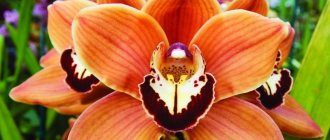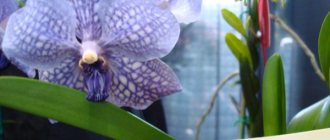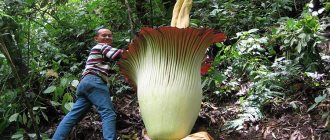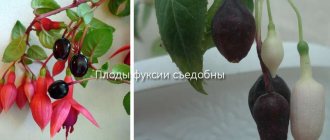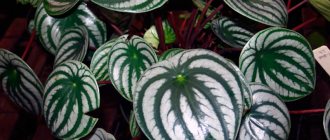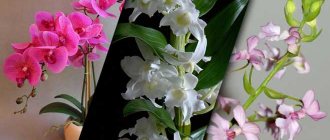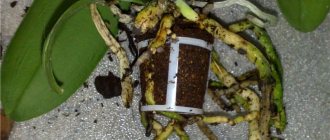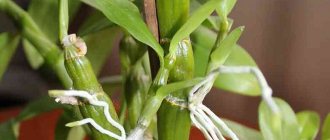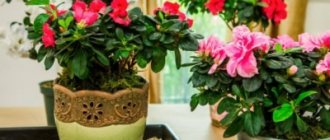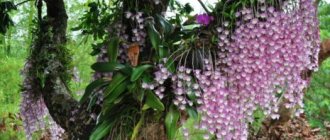Cymbidium is a species of orchid, an epiphyte from tropical forests. More than sixty Cymbidium hybrids have been bred for home floriculture..
These varieties differ in the color of the petals, shape and height of the leaves. What they have in common is the incredible fragrance of the buds and long-lasting flowering with proper care.
You can read more about the description of the different subspecies of Cymbidiums and their characteristics in our first article about these orchids. Orchids of this genus are demanding of lighting and high humidity ; they will feel good when there are differences in day and night temperatures.
Choice when purchasing
When choosing an indoor orchid, you should pay attention to its condition:
- The root system must be well developed. The flower is sold in transparent pots, so it will not be difficult to see it. The roots of a healthy plant are olive-colored and fleshy. Bright green tips indicate an active growth phase. Aerial roots are elastic.
- The leaves are dense, light green in color. The edges of the leaf blade have a reddish edging. There should be no stains, deposits or spots on the surface. Do not buy a plant with wrinkled, limp leaves or dark green or reddish hues.
- Choose a flower that has open flowers and buds. The greater their number, the better.
- The growing point of a healthy flower is firm to the touch and elastic.
Read all the information about the types and varieties of cymbidum, of which there are more than fifty, in this article.
Insect pests
The lower surface of leaf blades and cymbidium buds are often colonized by spider mites in dry air conditions. Signs of their damage are small white dots on the underside of the leaf and the appearance of cobwebs. The leaf loses color, turns gray and soon becomes brown and lifeless.
The appearance of the greenhouse flat beetle on the leaves is not difficult to determine - the leaf plates are deformed, acquire a silvery-white color, and small punctures are barely visible on their surface. During flowering, the cymbidium buds are parasitized by the beet aphid.
Cymbidium is also often damaged by mealybugs and scale insects. On leaves infested with parasites, miniature light yellow spots are formed, which over time become depressed, brown, crimson-violet. These insects secrete honeydew, which produces sooty fungi.
Cymbidium and types of thrips - greenhouse and tobacco - are found on orchids. They are difficult to notice on an orchid; their attack can be judged only by the characteristic silvery color of leaf areas with dark dots of excrement. Considerable harm is caused to cymbidium transferred to the garden by slugs and snails.
Mealybug on Cymbidium orchids
How to care for a cymbidium orchid?
Compliance with the conditions for growing an orchid and caring for it at home will allow you to get a beautiful flowering plant:
- Temperature conditions. Required temperature for flowering: +22…+24 °C. During the rest period: at night +11…+14 °С, during the day +18 °С. If the room is too hot, the flower is taken out to the balcony.
- Lighting. The plant loves bright, diffused light. Therefore, the pot is placed on the east side of the room. If it is on the south side of the window, then be sure to shade the light. In winter, when there is a lack of lighting, artificial sources are installed.
- Feeding and fertilizer. Feeding of the flower is carried out during the period of active growth of young shoots 2 times a month. They use “Tsitovit”, “Agricola”, “Flower Paradise”. Before flowering begins, potassium-phosphorus preparations are added. Do not feed during flowering. They use “Bona Forte”, “Ideal”, “Effect”, “Biomaster”, “Osmokot” and others.
Conditions of detention
Optimal ratio of soil components
Soil for Cymbidium:
- purchased ready-made mixture for orchids;
- self-prepared soil mixture. Take in equal proportions: pine bark (up to three centimeters in size - for large species; for miniature species - 1 cm);
- sphagnum moss;
- fern roots;
- peat;
- charcoal.
Expanded clay is also used as drainage.
Substrate for orchids.
Temperature conditions in flowering and dormant states
During the period of active growth, temperature fluctuations should be at least five to six degrees.
Good temperature readings:
- summer day: +20–27 °C;
- summer at night: +18–22 °C;
- from autumn to spring during the day: up to 18 °C;
- from autumn to spring at night: +10–12 °C.
With this content, flower buds will form well. During flowering, the temperature should be stable around +22–26 °C.
During the dormant period, it is recommended to move the flower to a room with an air temperature of up to +18 °C.
Air humidity for healthy growth
The optimal air humidity for keeping Cymbidium is 40–50%. During the growth of new pseudobulbs, it is recommended to increase the humidity to 50–60%.
To maintain humidity in a dry room:
- spray the plant 2-3 times a day; if the flower is in a cool room, stop spraying;
- place the flower with the pot on a tray with expanded clay and keep it moist;
- use a humidifier .
Orchids can be sprayed to increase humidity.
Location illumination
The optimal place for Cymbidium to grow is a large window on the southeast side . The flower loves diffused sunlight. In summer, protect it from direct rays of the sun, which lead to burns of leaves, bulbs and petals.
If there is a lack of light, the peduncle will not form or the flowering will be weak and short-lived, the leaves will lose turgor and become flabby.
Soil moisture
The question “When and how to water?” - one of the most common among beginners.
Cymbidium requires regular watering of the soil once a week - in summer; once every two weeks - in winter.
The plant can survive short-term drought thanks to pseudobulbs that accumulate moisture when watered.
REFERENCE! Pseudobulb, bulb, false bulb or tuber, tuberidium is the name of the above-ground part of the plant from which shoots emerge.
Errors when watering:
- lack of watering - the bulbs wrinkle, unopened buds fall off;
- overwatering and accumulation of moisture at the roots - root rot, in which black spots appear on the leaves.
Undesirable neighborhood
- flowers that have different requirements for light, temperature and humidity;
- plants with a strong aroma: citrus fruits, laurel, geranium ;
- a large harvest of apples and nuts emit ethylene, which leads to premature yellowing and drying of leaves and reduces flowering.
Composition of soil for growing
Suitable soil for orchids can be purchased at a garden store. It should be labeled “For Cymbidium and other terrestrial orchids”, containing bark and moss.
Expensive mixtures, in addition to the main composition, may contain pine bark, fern roots, charcoal, coconut chips, etc.
If there is no suitable substrate, then you can make it yourself. Take the components in equal parts:
- charcoal;
- fern roots;
- pine bark chips;
- broken walnut shell;
- sphagnum moss.
The main condition for suitable soil is good moisture permeability and looseness. Expanded clay is used as a drainage layer.
Read about ways to grow plants without soil at all here.
How to transplant: transplant instructions
An orchid can be replanted no more than once every two years. Usually transplantation is carried out for several reasons:
- the substrate has become too dense, depleted and deteriorated;
- the plant began to grow too quickly, which is why many new pseudobulbs appeared on it (the old ones became absolutely useless and only interfere with the normal development of the flower);
- rotting processes were noticed in the orchid.
Before replanting cymbidium, make sure that you have fresh, high-quality substrate and a new planting container ready. The orchid should be placed in the pot so that its growth point (new pseudobulbs) is in the central part of the pot. After transplanting, place the container with the plant in partial shade or in the garden under a tree crown .
Important! During transplantation, old pseudobulbs are removed from the plant.
Reproduction
The orchid reproduces in several ways: by dividing the bush, by root shoots, by children, by seed. At home, choose the simplest methods:
- Root shoots. When transplanting, the tangle of roots is difficult to untangle. The roots break off, resulting in small shoots. They are placed in a new pot and sprinkled with crushed activated carbon - new shoots will grow.
- Dividing the bush. Divide the pseudobulb with roots into shoots. Transplant into a separate pot. Water deeply until roots are established and new shoots appear.
- Division of the bulb. Old pseudobulbs without roots and leaves are placed on moss, greenhouse conditions are created, and they are regularly sprayed with water. After the sprouts appear, they are transplanted into a pot.
- Reproduction by children. In order for the babies to appear, they create stressful conditions for the flower: reduce watering and place them in a cool place. After the first flower buds appear, the plant is returned to its usual care regimen. Buds that do not produce flowers will send out roots. When they grow, the baby is separated from the mother plant.
Diseases
The most common diseases of cymbidiums are root rot, which later spreads to pseudobulbs and leaves. Brown rot affects young foliage and stems under conditions of abundant watering at low air temperatures. Watery brown spots grow very quickly and if they spread to the stems, the orchid cannot always be saved. The affected areas are cut out, and the cut areas are sprinkled with charcoal powder.
Gray rot is observed on cymbidium flowers in cold rooms with high air humidity. Diseased flowers are cut off, and the air temperature in the room is increased.
Anthracnose is a fungal disease that mosaically stains orchid foliage with brown spots. Among the particularly dangerous diseases is cymbidium mosaic, the causative agent of which is the cymbidium black roughness virus. Diseased orchids are discarded.
Root rot in cymbidium orchid
Diseases and pests: photos, descriptions and treatment
The flower is susceptible to attack by pests and diseases if the care regimen is violated. To combat them, soak a cotton swab in a soap solution and wipe all parts of the plant. Then they spray with chemicals, for example, “Aktellik”, “Fitoverm”, a solution of garden green soap.
Frequent orchid pests: scale insects, spider mites, aphids.
Diseases and how to fight:
- Root or pseudobulb rotting. Reduce the amount of watering, replant in a new pot and dry substrate. Do not water for two weeks.
- Viral mosaic. Appears as yellow spots or brown stripes on the leaves. The disease cannot be treated; the flower must be isolated from other plants.
- Swelling of leaves. With abundant watering and low temperature in the room, growths with a watery shell form. It is necessary to increase the temperature and stop watering until the soil dries out.
- The buds are falling. Occurs due to a lack of microelements: phosphorus or calcium. The solution is to add fertilizer to the substrate.
- Leaves turn yellow or dry out. The cause may be a pest (spider mite), excess sunlight, dry air in the room, or death of the roots. Check and eliminate these causes: treat with chemicals, humidify the air, replace the pot and examine the root system.
Aphids on Cymbidium
Scale insects are a common plant pest.
Cymbidium leaves turn yellow
Cymbidium orchid: home care
Cymbidium belongs to the sympoidal orchids, in which each season a new pseudobulb appears with elongated sword-shaped or linear leaves, often reaching a meter in length. Cymbidium flowers range from small to large, bright, of various colors - snow-white, greenish, yellow-light green, cream, terracotta, lemon, various shades of pink and red. Petals and sepals are usually the same shape and color, the lip is brighter and always variegated. The lateral lobes surrounding the column are smooth, the middle one is arched.
Lighting
Exotic cymbidiums are considered one of the light-loving orchids, so sufficiently lit places are chosen for them indoors. In winter, they are provided with additional lighting with special lamps. The lack of light affects the process of bud formation: if there is not enough light, they crumble and the flower stalks dry out. Attention! During flowering, cymbidium cannot be moved - the flower buds fall off.
Fertilizers
Plants are fed only during the period of increasing vegetative mass from May to November, twice a month. For these purposes, use special fertilizers for orchids or liquid mineral fertilizers for beautifully flowering indoor plants in half concentration.
New growth of Cymbidium orchid
Temperature
The optimal thermometer readings in the room where the cymbidium orchid grows are allowed within 20–25 degrees in the summer and 8–15 degrees above zero in the winter. With the arrival of warmer weather, orchids are moved to a terrace or semi-shaded balcony. Placement in the fresh air at lower night temperatures initiates the acceleration of the development of flower stalks with buds. It is only necessary that ants or snails do not settle in the cymbidium pot in the garden. In late September, the orchid is brought back into the building.
Watering and air humidity
From May to August inclusive, cymbidium is moistened weekly, in September and October - once every 2 weeks. With the end of flowering in March and April, the plants are not watered - at this time they are in a dormant state.
Important! During the flowering period of cymbidium in November - February, the substrate in its pot should not dry out - otherwise the flowers will fall off.
The plant loves watering by watering. During flowering, the petals evaporate a lot of moisture, and the pseudobulbs of a blooming orchid look wrinkled and dried out. The pot with the plant is immersed in warm water for 1–2 hours so that the water reaches the upper level of the flower container. During this time, the pseudobulbs absorb enough water and become elastic again.
Cymbidiums respond favorably to spraying; it is advisable to avoid getting moisture on the blooming flowers and inside the rosette. The optimal air humidity in the room where cymbidium is kept is 50–70%.
Cymbidium Khan Flame 'Lucifer'
Possible problems
Doesn't bloom
The absence of flowering for a long period indicates disturbed temperature conditions and lighting. To force it to bloom, first create stressful conditions for it, and then provide optimal conditions for flowering. How to solve this problem, read this article.
The tips of the leaves turn black
The reason is that the plant was overfed with fertilizers. Dip the flower pot in water and rinse it to remove excess.
What other diseases of orchid leaves are there and how to treat them, read here.
Resuscitation without roots
Cymbidium is easy to quickly grow roots. If the flower is left almost without roots, do the following to resuscitate them:
- remove from the pot and soak in water for 2–3 hours;
- unravel the roots, removing with a knife all damaged, dry, loose roots;
- the cut ends are treated with an antiseptic, for example iodine, alcohol, garden pitch;
- dry the roots and sprinkle with charcoal, leave for 24 hours;
- After this, they are planted in a new substrate and not watered for 2 weeks.
Transplanting a cymbidium orchid
For every novice orchid grower who has decided to try his hand at growing beautiful flowers, an initially important question is: how to replant a cymbidium orchid? After all, a plant that arrives at home will sooner or later have to change the substrate to fresh one. Other reasons for transplantation also play a key role:
- young shoots literally “fall out” over the edge of the pot;
- the new shoots developing from the new pseudobulbs have grown to a size of 5–7 cm and are ready to separate from the mother plant to develop independently.
Cymbidiums are best replanted after spring flowering, which usually ends in early April. To replant, you will need a new flower container, the diameter of which is 5 cm larger than the previous one. Considering that the roots of cymbidium are long and powerful, special pots are selected for them - tall and stable, shaped like a vase. It is necessary to prepare disinfected scissors to trim dead and rotten roots.
Possible options for substrate components for cymbidium orchids:
- soil mixture for ground orchids purchased at a flower shop;
- store-bought substrate for orchids and soil for seedlings, combined in a 3:1 ratio;
A self-composed substrate includes the following components:
- small fragments of pine bark, osmunda roots, pieces of crushed stone or ceramics, charcoal and sphagnum moss;
- pine bark, rotted peat, sphagnum moss mixed with chopped fern roots and charcoal;
- humus, peat, sphagnum moss and sand with the addition of fern root system and charcoal.
What is the best way to transplant cymbidium:
- The powerful roots of cymbidium adhere so tightly to the inner surface of the flower container that it is extremely difficult to pull them out. It is advisable to immerse the pot in water for at least an hour before replanting and thus water it.
- Holding the plant firmly by the old pseudobulbs, pull it out of the flower container. Pay close attention to newly emerged young shoots - they are very fragile and break easily.
- Inspect the roots, shaking them off and freeing them from the used substrate. If there are damaged ones, remove them with scissors.
- Strong and healthy white roots are lowered into a new container and fresh substrate is poured into the space between the root system and the walls of the container. Make sure that the bases of the pseudobulbs are located at the same level with the surface of the soil mixture.
- The transplanted cymbidiums are not watered for the first day - time is needed for minor damage to the plant’s root system to dry out and heal.
- For a month after transplantation, cymbidium is not fertilized. The terminal sections of young roots are too sensitive during this period and can only withstand feeding at half the dose.
Further care
Immediately after transplantation, the pot with cymbidium is transferred to a shaded place. It is best to keep the plant cool and with minimal humidity for several weeks. This principle of care will help the plant take root faster in a new place.
Be sure to water the flower 24–48 hours after planting and treat it with a mild fungicidal or bactericidal solution to reduce the likelihood of infection by a fungus or bacterial disease.
Errors during cultivation
In fact, there can be a lot of mistakes. Most of them relate to improper care and maintenance of the plant.
- If the tips of the leaves turn black , this may be a symptom of overfeeding. Since excess useful components accumulate precisely at the ends of the leaf blades, they will first begin to turn black and die with an excess of fertilizers. Only flushing can come to the rescue. Dip the plant substrate into water and wash off excess salts.
- If the ends of the orchid's leaves turn yellow or brown , then this indicates that the air in the room is too dry. It is necessary to increase the humidity level in the room with the plant as soon as possible.
- The appearance of sticky drops on the leaves signals a strong difference in day and night temperatures. Although sometimes this symptom may indicate the presence of harmful insects or a viral infection.
Types and varieties of cymbidium
We invite you to get acquainted with the most attractive types of cymbidium in our opinion.
Cymbidium eburneum
Or “ivory” is distinguished by large petals of a very beautiful creamy shade. The aroma of the flower resembles the smell of lilac. The orchid blooms in spring and prefers moderate temperatures.
Cymbidium aloifolium
A miniature orchid, reaching a height of only 30 cm, with beautiful flowers of pale yellow with burgundy and cream shades. Flower diameter 4.5 cm.
Cymbidium lancifolium
An orchid with flowers up to 5 cm in diameter, in which the sepals and petals are light green with a central dark red vein, and the lip is white and green with red-brown stripes on the side lobes and with red specks and spots on the middle one. Blooms from April to October.
Day's Cymbidium (Cymbidium dayanum)
It has a multi-flowered inflorescence with flowers 5 cm in diameter. Sepals and petals are ivory-colored with a dark red central vein, the white lip has a strongly curled front lobe, the callus is cream or white. The orchid is native to the Philippines and Sumatra. This species blooms from August to December. The most famous varieties are “Twelve” and “Tavoy”.
Cymbidium tracyanum
It is a multi-flowered orchid with fifteen-centimeter diameter, very fragrant flowers of a yellow-green hue with dotted red-brown lines along the veins. The lip is wavy and sometimes fringed along the edge, cream-colored with red stripes and spots along the anterior lobe. The brush reaches 120 cm in length and has up to 20 flowers. Blooms from September to January.
Cymbidium lowianum
An epiphyte whose flowers reach 20 cm in diameter. Their sepals and petals are also greenish-yellow, and the three-lobed lip is dark crimson with a yellow outline along the edge of the middle lobe. The inflorescence is multi-flowered. The orchid reaches almost a meter in height, the leaves are linear, 75 cm long. The plant’s homeland is Burma. Flowering occurs from February to June. The most popular variety is “Lilliput”.
Cymbidium eburneum
Originally from the Himalayas. This is a large plant with arched racemes and linear leaves. The fragrant flowers reach a diameter of 7.5 cm, they are cream-colored, the lip is wavy along the edge, at the base with a yellowish ridge surrounded by red specks.
Cymbidium ensifolium
A terrestrial orchid that grows in rocky areas. Its petals are light yellow with burgundy veins, and there are burgundy specks at the base of the petals. The lip is greenish or pale yellow, the middle lobe is speckled with dark red, the lateral lobes have brown stripes. The inflorescence consists of 3-9 very fragrant flowers 3-5 cm in diameter, the peduncle is erect from 15 to 65 cm in height. Blooms from January to April. Hybrids c are grown in culture. sword-leaved Golden Elf, Peter Pan, Lovely Melody.
- Indoor pepper: work a month after sowing - what should you water with after picking?
Cymbidium insigne
It is distinguished by white or pale pink petals with red spots. The lobes of the lip are also spotted with purple; the wavy edge of the anterior lobe is curved backwards. The inflorescence with 9-15 flowers, 7-8 cm in diameter, is loose, vertical, up to 80 cm high. Homeland - Thailand, China, Vietnam. Blooms from February to May. Epiphyte.
Cymbidium pumilum
It usually has red-brown petals with yellowish edges. The lip is white with dark red spots, its middle blade is blunt-pointed and curved. The almost erect inflorescence reaches a length of 12 cm, and the diameter of the flower is 10 cm on average. The plant's homeland is Japan and China; this orchid blooms from December to March. A very rare species.
Cymbidium giganteum
It has up to 15 fragrant flowers in an inflorescence, 10-12 cm in diameter, with yellow-green petals covered with red stripes, and with a cream-colored lip, also spotted and striped. The inflorescence, hanging from a powerful peduncle, reaches a length of 60 cm. It grows in nature in the Himalayas. It blooms from November to April, and the flower does not fade for 3-4 weeks. The popular Red Chile variety is a compact plant with bright red flowers.
About the features of watering
How to water cymbidium? Its watering should be moderate and directly dependent on the ambient temperature: the warmer the air in the room, the more often and more abundantly the flower should be watered.
- Excess moisture should flow freely from the pots, giving the substrate the opportunity to dry out between waterings. There can be no talk of any stagnation of liquid in the pot. In relation to cymbidium, the rule is true: “underfilling is better than overfilling.” It is able to withstand short periods of soil drying due to pseudobulbs, which create quite significant reserves of moisture.
- Confirmation that the orchid needs regular watering is the absence of condensation on the walls of the flower pot. You can also use the traditional method by plunging your finger into the thickness of the substrate. Water for watering an orchid should be boiled or settled, and its temperature should be a couple of degrees higher than the ambient temperature.
- If watering the cymbidium is carried out from above, care must be taken to ensure that the water does not get into the very core of the leaf rosette, since stagnation of liquid in it can destroy the plant, causing tissue rotting. If this does happen, you must immediately remove the liquid from the growing point using a soft cloth.
- It is best to water cymbidium by immersing the plant pot in a deep container of water. This method of watering eliminates the risk of liquid getting into the growing point, and also helps to uniformly moisten the substrate in the pot. The best time to water an orchid is in the morning. The water accumulated in the pan must be drained so as not to cause rotting of the root system.
- When watering cymbidium in winter, you should remember that at this time it is permissible to do this no more than twice a month, but severe drying out of the soil is still unacceptable. An acute lack of fluid can lead to shrinkage of pseudobulbs and premature falling of flowers. At the same time, rare watering stimulates the appearance of new flower stalks.
- Wrinkling of pseudobulbs (even significant) should not be a cause for serious concern: you just need to water the cymbidium, and in two days their lost turgor will be completely restored. If, after watering, the pseudobulbs remain wrinkled and flabby, this means that problems have arisen with the functioning of the root system. To correct the situation, the frequency of watering should be reduced and wait until the young roots grow.
Appearance of flower stalks
To achieve the appearance of pseudobulbs, that is, flower stalks, you need to follow the watering regime and provide the plant with a normal temperature. Flowering time is mid-spring. The flower does not like the intense summer heat of Russian latitudes. That is why all transplants are done in March - February.
During the cold period of the year (October - March), the suitable temperature for keeping cymbidiums is up to 20° C during the day, and at night - 10 - 12° C. But as soon as the first buds outside the window begin to bloom, you can already start replanting the cymbidium.
It will be difficult to see cymbidium blooming in an apartment. You can force an orchid to produce a bulb when the growing conditions are ideal for it.
It is necessary to shade the windows and maintain a strictly certain temperature in the room during the day and a suitable temperature at night. The main condition for the blooming of buds is temperature changes. However, small varieties of the flower are more accustomed to climate conditions in mid-latitudes. A daily temperature difference of 5−8°C is enough for them .
These are the varieties that are best kept in an apartment. Large and large-leaved varieties, such as cimbidium grrootblomig joel, need a daily difference of 10 to 15°C. There is no need to be afraid of the flower freezing. Cymbidiums are accustomed to mountainous areas and can withstand very low temperatures - about 3-5 degrees Celsius at night.
